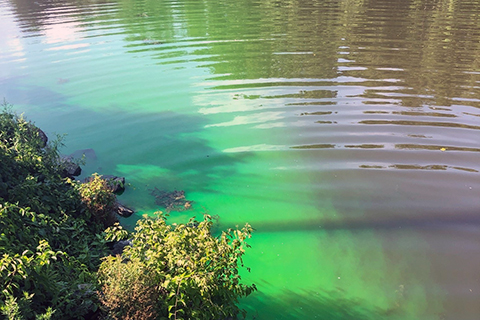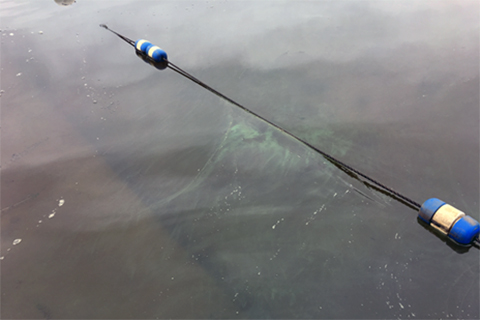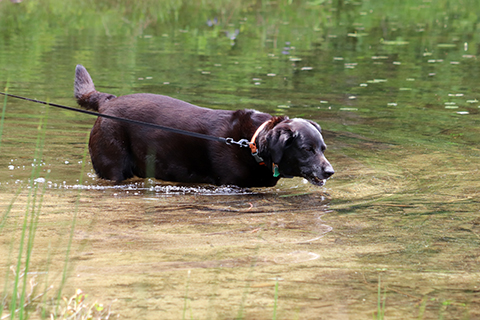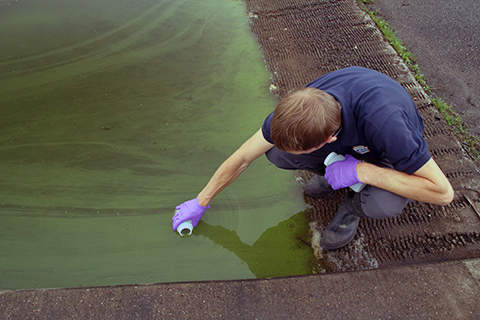As water temperatures rise during the summer, the risk for harmful algal blooms to occur increases. The typical season for these blooms is the middle of June to late August; however, it can extend through the fall months.
Harmful algal blooms -- sometimes called blue-green algae -- have occurred in the past in Pennsylvania on Lake Erie at Presque Isle State Park, and several other state park lakes.
People, and especially pets, should avoid exposure to harmful algal blooms.
Harmful algal blooms occur when certain kinds of microscopic organisms in a waterbody or waterway produce toxins or other harmful compounds in concentrations that can harm people, pets, or wildlife.
The microscopic organisms that most commonly cause harmful algal blooms in Pennsylvania are known as cyanobacteria.
Harmful algal blooms have been observed worldwide in all types of water including lakes; ponds; retention basins; rivers and streams; and reservoirs.
The Department of Conservation and Natural Resources is part of a multi-agency Harmful Algal Blooms Policy Task Force outlining steps to:
- Monitor, respond, and prevent blooms
- Make people aware of safe water recreational practices for preventing contact
- Implement a notification system state parks and other lakes, waterbodies, and waterways statewide
Characteristics and Causes of Harmful Algal Blooms

A harmful algal bloom can look like foam, scum, or mats particularly when wind blows them toward a shoreline.
The blooms can be blue, bright green, brown, or red and are sometimes described as looking like paint floating on the water.
Some blooms are not visible at the water surface. As a bloom dies, it can smell bad -- similar to rotting plants.
A healthy waterbody generally contains a variety of different types of algae and other microscopic organisms present at any one time.
The concern occurs when this diversity decreases; and, instead, the waterbody becomes dominated by cyanobacteria capable of producing concentrations of toxins and other harmful compounds that can cause illness.
Visual conditions often can indicate a potential harmful algal bloom, but some never produce a high enough concentration to be toxic. Harmful algal blooms can only be identified with water testing.
Blooms generally occur when there are warm, sunny, calm conditions and where there are high levels of nutrients present.
People can contribute to the presence of nutrients in runoff of fertilizer from yards and fields, in urban stormwater runoff, and in treated wastewater.
How to Limit Exposure to Harmful Algal Blooms

To limit exposure you should follow safe practices:
- Stay out of water that has foam, scum, or discoloration
- Do not swallow untreated surface water or let pets drink
- Avoid inhaling lake or river water
- Don’t let children or pets play in debris on shore
- Don’t drink or cook with suspected water -- treatments like boiling, bleach, or water filtration units offer no protection from harmful algal bloom toxins
- Wash your hands after contact with untreated water
- Shower or bath people and pets with fresh water as soon as possible after water recreation activities
- Pay attention to any waterbody advisories or closures
Harmful Algal Blooms Can Make People and Pets Sick

Dogs are much more susceptible than people to being poisoned after exposure to a harmful algal bloom from drinking the water, eating mats or scum, having skin contact with the water, and grooming after leaving the water.
They are often attracted to the odor. Signs of toxic poisoning in pets include:
- Excessive drooling
- Weakness
- Staggered walking
- Difficulty breathing
- Convulsions
If you suspect your dog has been exposed, call your veterinarian right away.
People also can get sick with symptoms, including:
- Rashes
- Eye and nose irritation
- Abdominal pain and diarrhea or vomiting
- Numbness of lips and tingling fingers and toes
- Dizziness
- Headache
See a doctor if you think you might be ill from exposure to a bloom.
How Will You Know if There is a Harmful Algal Bloom?

Confirmation of an harmful algal bloom can only be made by testing for their toxins with a field or laboratory test.
Pennsylvania state parks will communicate with visitors when elevated risks from harmful algal bloom exposure are identified that would change recommended recreational uses and practices around the water.
The Centers for Disease Control and Prevention provides additional information about harmful algal bloom-associated illnesses.
The U.S. Environmental Protection Agency offers resources on nutrient pollution and harmful algal blooms.
For more information about harmful algal bloomss in Pennsylvania, contact HABs@pa.gov.